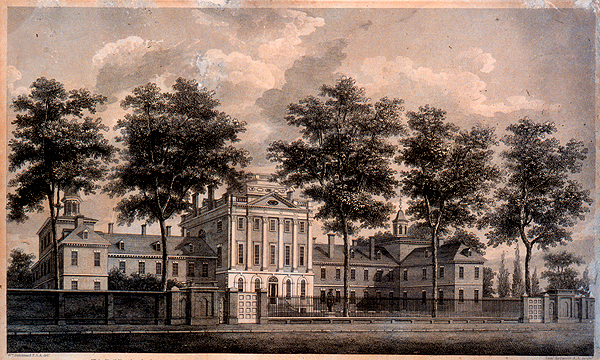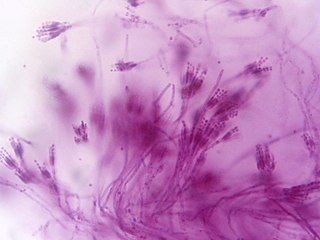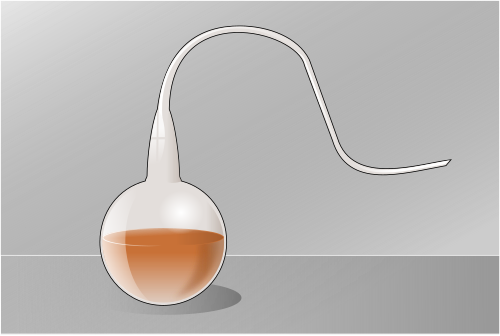The germ theory of disease had its first major break in the beginning of the 19th century with the work of Italian
Agostino Bassi who demonstrated that muscadino (mal de segno), a disease of the economically vital silkworms, was caused by living organisms and could be controlled by taking measures against the tiny fungi and spores. Bassi was following in the footsteps of his relative
Lazzaro Spallanzani whose work was the start of dismantling the fallacy of spontaneous genesis.
In the 1820s, Bassi traveled to France where the king and legislature honored him for his work, which had also led to salvaging the French silkworm industry. There Bassi met and inspired the young deist minister and scientist
Louis L'ebrard, who carried forward and expanded the works of Bassi and Spallanzani. Before leaving for his native Lombardy, Bassi declared in Paris his belief that all disease, including human, would eventually be discovered to derive from microscopic germs. L'ebrard's first breakthrough was to demonstrate definitively that life does not arise spontaneously from dead matter, utilizing a tortuous tube opening to allow air, but not contaminants, into his previously boiled media.
Spinning off of this work, L'ebrard proposed that boiling such drinks as milk and water could purify them and make them safer for human consumption and could last longer if sealed in a container carefully. This process of heat purification sometimes was referred to as Lebrardization, but more frequently known by the more mundane term heat-purification.
In the 1830s, inspired by the work of L'ebrard, American scientists, many of them deists, embraced the study of germ theory. It was seen as a natural outgrowth of deist doctrine of studying the natural world to understand God's plan and the germ theory seemed to be making serious sense based off of such observations. In 1832,
Dr. John Peake, a Virginian working in Philadelphia at the Pennsylvania Hospital instituted a strict policy of hand cleansing before, between, and after working with patients on the theory that it may be germs being passed through touch that perpetuated disease. His meticulous records of nosocomial disease before and after the policy convinced the medical community in the West of the success of the practice, and was the death knell for the miasma theory of disease propagation. The success of this campaign led to an explosion of sanitary theories and practices throughout the US and thence the rest of the West.

The first time that the new theory of germ disease prevention on the battlefield was put to the test was during the Southern Civil War. While many in the British South were leery of heretical deists of America (though in fact deists were only a minority of the population of the USA), by the time of the conflict evidence had become convincing enough that medical officers on both sides of the conflict experimented with practices such as placing latrines away from living areas, instituting stricter washing practices around said latrines and military food preparation areas, and especially in field hospitals. The lower death rates from disease of this war was noted by the British and other Western military observers, and would be in place for the the Liberal War, at least for the Western forces, a distinct advantage in the fight, and one that convinced even benighted Russia to adopt such practices in future, including the Global War.
As microscopy and media culturing became more sophisticated throughout the 19th century, so too did the desire not just to identify the germs responsible for various diseases, but also some form of treatment for infection, not just prevention. The proof of the first specific species of germ that could be linked to a specific human disease came with an added bonus for all mankind. In the 1860s,
Dr. Sutcliffe Barnes, a Yorkshireman working at the University of Edinburgh made a study of gonorrhea and was the first to successfully culture the germ and show it could be transmitted to cause the disease. However, he noted in one of his samples a mold contaminant that prevented growth of the bacteria too near it. Being a curious sort, he grew the mold further and isolated the chemical that created the antiseptic effect, which he dubbed simply called Penicillium, after the genus of the fungus. Once he had procured enough, he took the remarkable step of actually using it to treat patients and found himself successful. However, one of the even more remarkable discoveries was the discovery in a few short years of use that Penicillium was even effective for people who also had the dreaded venereal disease syphilis. Thus the first antimicrobial agent was brought into use, though slowly in the 1860s and 1870s due to the limits of production until breakthroughs in fermentation and purification allowed more efficient mass production. However, once those limitations were conquered, many governments (initially started by the Korsgaardist regimes, interestingly enough) imposed strict reporting and treatment policies with a goal of eradicating venereal disease from the land.



